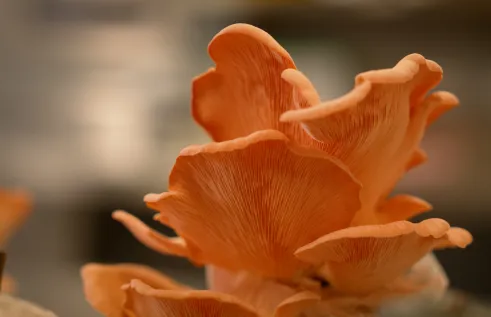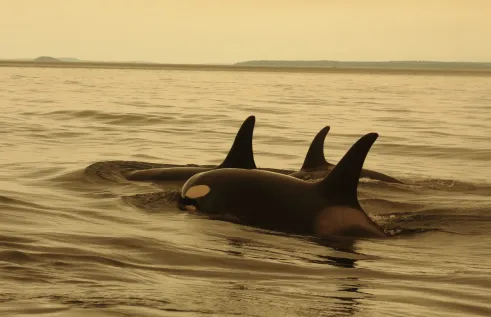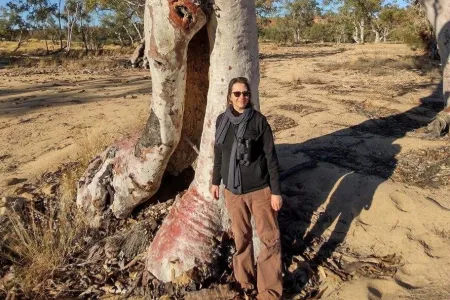News
Buffel grass risk to ancient trees explored in Central Australia
Long-term research at Charles Darwin University (CDU) could help safeguard the longevity of river red gums that have figured in the arid riverine woodlands of Central Australia for hundreds of years.
CDU Ecologist from the Research Institute of Environment and Livelihoods (RIEL) Dr Christine Schlesinger is leading field studies to better understand and, ultimately, inform management strategies to curb the fire risk that invasive buffel grass poses to these centuries-old trees.
Dr Schlesinger said the increased frequency, intensity and extent of wildfire promoted by introduced grasses is one of the most serious threats to biodiversity in arid ecosystems.
“Buffel grass is a serious invader of desert ecosystems worldwide. It promotes more frequent and intense fire episodes, potentially threatening the persistence of large trees, particularly river red gums,” Dr Schlesinger said.
“Such old, large trees are keystone structures of terrestrial ecosystems that provide important habitat for wildlife. Their widespread decline, globally and in Australia, has serious implications for biodiversity and ecosystem integrity.”
Dr Schlesinger said river red gums are vulnerable to grass-fuelled fires because the trees are restricted to areas with high soil moisture and nutrients.
But these are also the areas in which buffel grass tends to thrive, effectively increasing the fuel load of fires in dryland habitats across Central Australia where the ancient gums occur.
For instance, a long-term monitoring site infested with buffel grass near Ormiston Gorge in the West MacDonnell Ranges, west of Alice Springs, showed about one-third of the site’s largest river red gums were destroyed by a major wildfire in January 2019.
“The severe, detrimental effect of a single fire, on trees estimated to be centuries old, is indicative of tree loss occurring across remote arid Australia in habitats where fire is now predominantly fuelled by invasive grasses,” she said.
“We predict a further decline in the abundance of large trees from fires will occur widely throughout arid Australia over the next decade, with substantial long-term impacts on multiple species.”
A new field survey of keystone river red gums and invasive grasses in the Todd River, at Wigley Waterhole and Gorge in the Alice Springs Telegraph Station Historical Reserve, during July will help to assess the extent of fire risk stemming from buffel grass.
In the event of a future wildfire, monitoring the fate of the trees will help bridge the knowledge gap in research exploring the impacts of fire fuelled by buffel grass, and build baseline data to inform management strategies.
Students participating in the surveys are also set to gain knowledge of field techniques and research skills, and arid-zone ecology, with a focus on desert rivers and waterholes.
Dr Schlesinger said the river red gum surveys, now running for six years, are part of a CDU Desert Field Ecology unit developed for students in their final year of a degree in Environmental Sciences or a Master of Environmental Management.
The unit also comprises surveys of bird species linked to large river red gums led by Dr Schlesigner, and surveys of aquatic invertebrates and fish led by CDU RIEL researcher Professor Jenny Davis.
Most students participating in the unit are from CDU, but this year the cohort also includes ten students from the University of the Sunshine Coast (UniSC) and their lecturer Dr Gabriel Conroy, who will assist in leading the river surveys.
“This is the second year that CDU has partnered with UniSC, giving Sunshine Coast students the opportunity to join the CDU Desert Field Ecology unit, and in turn, CDU students have the opportunity to study coastal environments in Queensland later this year.
“Learning to understand ecological processes, such as fire and weed interactions, in very different ecosystems is an invaluable experience for the students.”
The CDU surveys examining tree, bird and aquatic species are being conducted over seven days from Monday, July 18 to Sunday, July 24.
More here: Impacts of a single fire event on large old trees in a grass-invaded arid river system
Related Articles

Cotton trash to treasure: Project using waste to grow new mushroom industry
Supermarket shelves could be stocked with mushrooms grown from the Northern Territory’s cotton waste, with a Charles Darwin University research project exploring the possibility of broadening the region’s agricultural industry.
Read more about Cotton trash to treasure: Project using waste to grow new mushroom industry
Stereotypes holding back Australia’s recreational fishing future, new study finds
Outdated stereotypes about who a “real fisher” is could be costing Australia’s recreational fishing industry valuable talent, creativity, and growth, new research from Charles Darwin University suggests.
Read more about Stereotypes holding back Australia’s recreational fishing future, new study finds
Global body adopts policy to protect Earth’s old, wise and large animals
The International Union for Conservation of Nature (IUCN) has recognised Charles Darwin University-led research into the Earth’s oldest animals with the adoption of the ‘Longevity Conservation’ global policy principle.
Read more about Global body adopts policy to protect Earth’s old, wise and large animals
